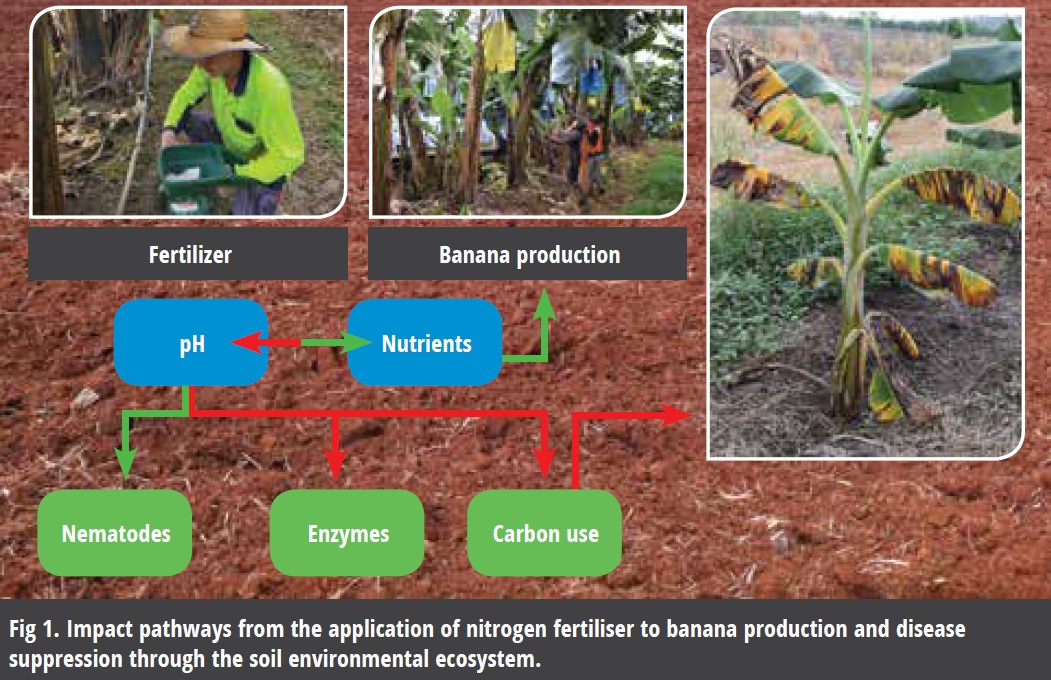By Hazel Gaza and Tony Pattison
Department of Agriculture and Fisheries, South Johnstone
Nitrogen application is an important component to profitable banana production.
The nitrogen applied to soil is taken up by the roots and used to produce chlorophyll in the leaves, giving them their green colour.
The more chlorophyll in the leaves, the greater the plants ability to photosynthesise, that is, to use the sun’s energy to produce sugars and starches.
The sugars and starches are used in plant growth, with a response that sees increasing nitrogen application increasing plant growth.
Nitrogen is also used in the soil by organisms to break down organic matter to release the carbon that is present. The carbon is used in the growth of the soil organisms. Banana soils tend to be relatively rich in organic matter, as the crop residue like leaves and pseudostems are returned to the soil, but require nitrogen to decompose it. The more nitrogen available in the soil the faster the decomposition rate of soil organic matter, which leads to changes in the microbial composition in the soil.
What happens to soil organisms and banana production when nitrogen applications are manipulated was investigated in a research experiment at the Department of Agriculture and Fisheries, South Johnstone Research Station.
Three nitrogen management systems based on urea were tested on non-Cavendish bananas; 350 kg N/ha/ yr (High N), 220 kg N/ha/yr (Low N) and 220 kg N/ ha/yr applied as Entec®, a nitrification inhibiting product to keep the nitrogen in the ammonium form (Low N+E).
After three years and three crop cycles the results showed that high N resulted in a decrease in soil pH making it acidic, dropping pH 5.6 to 4.9 under the high N, but remaining constant in the low N treatments. Acidic soils alter the solubility of nutrients, such as aluminium, which increases in availability. The available aluminium doubled under the high N. Excessive aluminium in the soil can retard root growth and restrict plant’s access to water and other nutrients like phosphate and calcium. Calcium was, reduced by a third following
three years of high N compared to low N. Calcium is important for proper cell wall formation, which protects the plants from pathogen penetration.
Nematodes are good indicators of changes in soil environments due to their abundance and diversity.
Under three years of high N, the nematode community decreased in diversity. In addition, the high N treatment caused an increase in the proportion of root-feeding nematodes, a decrease in microbe-feeding and predatory nematodes. Root damage caused by root-feeding nematodes can reduce banana production, but also increase the plant’s susceptibility to soil-borne pathogen like Fusarium wilt.
Investigating the soil microbial dynamics further, the high N decreased the soil microbial functional diversity. When soil microbes were provided with different carbon sources, such as simple sugars, carboxylic acid and amino acid, the microbes in the soil that had three years of high N application were not as efficient at degrading those food sources compared to the soil organism with three years of low N+E. A similar result occurred when soil microbial enzyme activity was compared. It was observed that the soils with three years of high N
always had lower enzyme activity compared to low N and low N+E. It could be viewed that three years of high N had made the soil microbes “lazy”, as they no longer had to scavenge for nitrogen to access carbon in soil organic matter.
Having a diverse soil microbial community can increase the likelihood that there will be more microorganisms that are antagonistic to Fusarium spp., resulting in a decrease in Panama disease severity. This was tested using a bioassay to grow Race 1 susceptible Ducasse banana plants in the experimental field soils. The results from the bioassay revealed that plants grown in soils that had a history of high nitrogen had a higher disease rating compared to plants grown in low nitrogen.
However, the effect of three years of low N, resulted in a 10% decrease in banana production compared with the high N. Bananas require the N for plant growth and good production. This means more efficient fertiliser practices, such as application frequency, forms, and the continual monitoring of leaf nitrogen are required if a balance between production and a disease suppressive soil microbial community is to be developed.
A comprehensive monitoring of the soil environment under different nitrogen management was mapped (Fig 1), which demonstrates that high nitrogen application has a flow on effect to the soil biological community. It exemplifies that in the long run, managing nitrogen inputs may be beneficial for the environment, but for banana growers, it can increase the plants resilience and the soil’s disease suppressive characteristics.
This project was funded by Hort Innovation, using the Hort Innovation banana research and development levy, co-investment from Queensland Government and contributions from the Australian Government. Hort Innovation is the grower-owned, not-for-profit research and development corporation for Australian horticulture.


